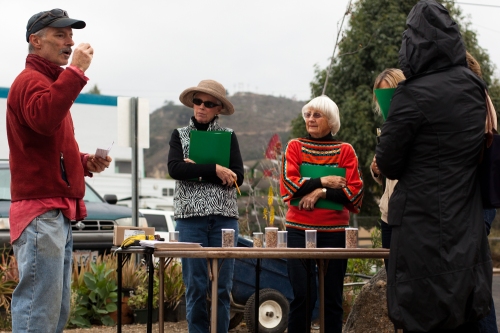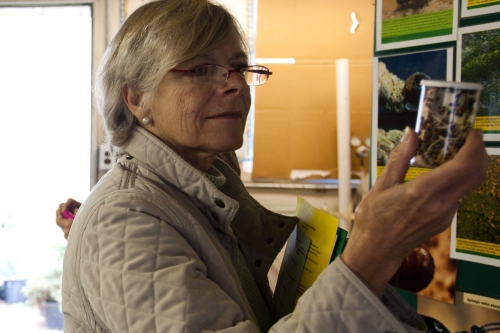This morning we hosted an informational tour of our facilities to the Garden Club of Santa Barbara. Five stations throughout the bug farm featured Deke’s Five Features of Integrated Pest Management: Releasing Beneficial Insects, Build Beneficial Refuges & Habitats, Monitor Insect Ecology, Integrate Cultural Practices and Use Soft Pesticides & Avoid Toxic Chemicals. Our sixth station featured a behind the scenes look of production back in Fly Alley.
Posts Tagged 'IPM'
Ant Control Weather
Published November 9, 2009 Ecology , Product Articles , Spotlight Leave a CommentTags: ant control, ants, Aphids, boric acid, IPM, mealybugs
When the temperature starts dropping it’s time to go on the offensive against ants. Ants are one of the biggest overlooked factors that lead to biological control failures. Many common species “farm” honeydew producing pests, including aphids and mealybugs. They eat and fight off predators, transport pests to new areas, and will even shelter aphids and mealybugs inside their ant mound. Cooler temperatures slow ants down, making them more vulnerable to attack by the vigilant farmer.
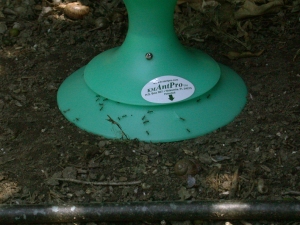
Formica ants visiting AntPro bait station
Physical disruption of ant nests provides more immediate results. Using a shovel or piece of rebar to break up the ground around the entrance to the colony forces ants that would be foraging to rebuild. If food supplies are low, the ants inside may eat their young. This allows beneficial insects to get to work without interference. Unfortunately, this is only a temporary solution and mounds will need to be repeatedly disturbed to distract the ants from tending to their honeydew source.
Other control measures you can use are nematodes, orange oil drenches, and sticky barriers. Read our Ant Bulletin and our founder Everett J. Dietrick’s paper Argentine Ants Must Be Suppressed for more information on ant control. This fall we’re also offering discounts on ant control supplies.
On an ant control side note, in a field study where they used only sticky barriers for ant control in an organic citrus grove, researchers found more aphids in the trees without ants! Their conclusion was that, as a side effect of excluding ants, they were also protecting the aphids from earwigs. After analyzing the populations of other aphid predators in their grove, they determined that earwigs are one of the main natural controls of aphids in the springtime. Populations of some of the other predators grew in response to growing aphid populations, but not fast enough to control them without the help from the earwigs.
Discussing the study at Rincon-Vitova, we thought of other predators we see a lot in orchards and gardens that would be blocked by sticky barriers – wolf spiders and ground beetles. Releasing aphid predators to back up the naturally occurring ones might have helped the aphid problem in the study grove. Or maybe another method of reducing ant interference without stopping crawling predators from finding the aphids, such as baiting, would have worked better in their case. Aphids can also be blasted off plants with a strong jet of water, which might be a good strategy if you are using sticky barriers. This study is a reminder of how complex these ecological systems are, and that we have to be alert to the unexpected effects our pest control efforts.
(The study mentioned, “Effects of the concurrent exclusion of ants and earwigs on aphid abundance in an organic citrus grove,” was written by Josep Piñol, Xavier Espadaler, Núria Cañellas and Nicolás Pérez and published in the August 2009 issue of BioControl (vol. 54, no. 4, pp. 515-527).)
-Alia Tsang, Bug Farm intern
Talking IPM with Andy Force at the Foellinger-Freimann Botanical Conservatory
Published January 29, 2009 RVI , Spotlight Leave a CommentTags: Amblyseius cucumeris, Atheta coriaria, beneficial insects, butterfly palm, Cryptolaemus, Encarsia formosa, ficus, Foellinger-Freimann Botanical Conservatory, hibiscus, IPM, Lindorus lopanthae, mealybugs, Orius insidiosus, Phytoseiulus persimilis, scale, spider mites, thrips, whitefly
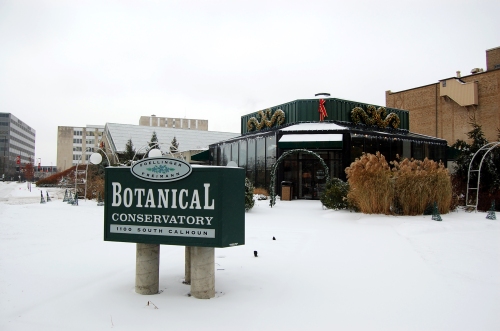
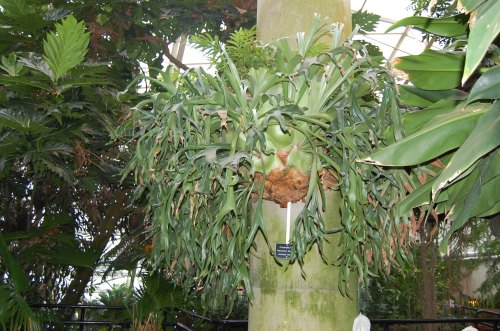
Staghorn Fern
Andy notices that the south side of the rooms in the conservatory get the most pest problems, and it is there that he does the most releases of beneficial insects. “The bananas, normally mealybugs like, but they tend to leave them alone. I bet if they were on that [the south] side of the house, they would get more mealybugs.” Since Andy has been working with an IPM program since 1991, he has an excellent handle on what pest problems his plants get, as well as when to expect them. The Ficus tree gets a lot of thrips, for which he periodically releases Atheta coriaria, Amblyseius cucumeris, and Orius insidiosus. Also, Andy has seen that the thrips are attracted to the light coming in through the exit door so he’ll open the door and shoo the thrips outside, as another control strategy. The Butterfly Palm frequently gets a scale infestation, and receives many of the Lindorus lopanthae beetles sent to the conservatory. Andy uses the Encarsia formosa cards on the Hibiscus to help combat the whitefly problems, and in the spring, the cacti bloom and typically get spider mites, which he controls with releases of the predatory mite, Phytoseiulus persimilis.

This Jaboticaba tree has been growing in the conservatory since 1983. As the tree matures, the bark peels and takes on a look similar to camouflage.
Stay tuned to learn about the Foellinger-Freimann Botanical Conservatory’s involvement with CITES and the exciting story that Andy Force shared with me about illegally smuggled orchids.




